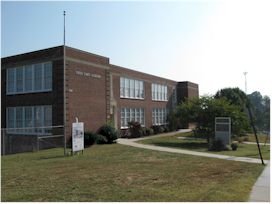
According to Beatrice Hairston's, A Brief History of Danville, Virginia, the town's first dedicated school for African-Americans was erected on Holbrook Street not long after the Civil War. First known as the Danville School, its name was changed to Westmoreland. In 1925, that first school was replaced with the brick building still standing near Gay Street, a rectangular, utilitarian structure with large banks of windows. For the first time, grade levels at this Westmoreland School were separated, primary in the main building and high school in the annex.
In 1936 a new high school, renamed for the educator John Mercer Langston, was erected around the corner on Gay Street. After Langston High School moved to Cleveland Street in 1963, the entire complex on Gay at Holbrook Street continued to survive, well into the era of desegregation, as Westmoreland Elementary School. Dubbed the Westmoreland School Apartments - for the building's last incarnation before it closed in the mid-1990s - it's actually the original mid-1930s Langston School, now refurbished as 19 senior apartments at 540 Gay Street.
Large, rectangular banks of windows bring natural light into spacious former classrooms-cum-apartments. These banks of windows emphasize the I-shaped brick building's horizontal alignment, with low cubic form and simple ornament reflecting the Moderne style. Reinforcing this machine-age motif is an elaborate decorative stone surround of geometric shapes around each of two entrances that extends upward to incorporate the window above as shouldered trim.
As with their other Danville projects - Schoolfield School Apartments and Lynn Street Lofts - the adaptive reuse specialists at Rehab Builders, a construction partner with The Landmark Group that oversaw the Westmoreland project, has shown respect for the building's institutional character. Some apartments, for example, retain old chalkboards and school lockers.